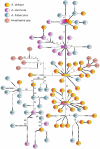Positive and purifying selection influence the evolution of doublesex in the Anastrepha fraterculus species group
- PMID: 22428050
- PMCID: PMC3302808
- DOI: 10.1371/journal.pone.0033446
Positive and purifying selection influence the evolution of doublesex in the Anastrepha fraterculus species group
Abstract
The gene doublesex (dsx) is considered to be under strong selective constraint along its evolutionary history because of its central role in somatic sex differentiation in insects. However, previous studies of dsx used global estimates of evolutionary rates to investigate its molecular evolution, which potentially miss signals of adaptive changes in generally conserved genes. In this work, we investigated the molecular evolution of dsx in the Anastrepha fraterculus species group (Diptera, Tephritidae), and test the hypothesis that this gene evolved solely by purifying selection using divergence-based and population-based methods. In the first approach, we compared sequences from Anastrepha and other Tephritidae with other Muscomorpha species, analyzed variation in nonsynonymous to synonymous rate ratios (dN/dS) in the Tephritidae, and investigated radical and conservative changes in amino acid physicochemical properties. We show a general selective constraint on dsx, but with signs of positive selection mainly in the common region. Such changes were localized in alpha-helices previously reported to be involved in dimer formation in the OD2 domain and near the C-terminal of the OD1 domain. In the population-based approach, we amplified a region of 540 bp that spanned almost all of the region common to both sexes from 32 different sites in Brazil. We investigated patterns of selection using neutrality tests based on the frequency spectrum and locations of synonymous and nonsynonymous mutations in a haplotype network. As in the divergence-based approach, these analyses showed that dsx has evolved under an overall selective constraint, but with some events of positive selection. In contrast to previous studies, our analyses indicate that even though dsx has indeed evolved as a conserved gene, the common region of dsx has also experienced bouts of positive selection, perhaps driven by sexual selection, during its evolution.
Conflict of interest statement
Figures





Similar articles
-
The gene doublesex of Anastrepha fruit flies (Diptera, Tephritidae) and its evolution in insects.Dev Genes Evol. 2007 Oct;217(10):725-31. doi: 10.1007/s00427-007-0178-8. Epub 2007 Sep 11. Dev Genes Evol. 2007. PMID: 17846784
-
Evidence for positive selection in the gene fruitless in Anastrepha fruit flies.BMC Evol Biol. 2010 Sep 24;10:293. doi: 10.1186/1471-2148-10-293. BMC Evol Biol. 2010. PMID: 20868501 Free PMC article.
-
Molecular evolution and genetic diversity of defective chorion 1 in Anastrepha fraterculus and Anastrepha obliqua (Diptera, Tephritidae).Dev Genes Evol. 2024 Dec;234(2):153-171. doi: 10.1007/s00427-024-00723-3. Epub 2024 Nov 7. Dev Genes Evol. 2024. PMID: 39509071
-
Genetics and biology of Anastrepha fraterculus: research supporting the use of the sterile insect technique (SIT) to control this pest in Argentina.BMC Genet. 2014;15 Suppl 2(Suppl 2):S12. doi: 10.1186/1471-2156-15-S2-S12. Epub 2014 Dec 1. BMC Genet. 2014. PMID: 25471175 Free PMC article. Review.
-
Extensive purifying selection acting on synonymous sites in HIV-1 Group M sequences.Virol J. 2008 Dec 23;5:160. doi: 10.1186/1743-422X-5-160. Virol J. 2008. PMID: 19105834 Free PMC article. Review.
Cited by
-
The ubiquity and ancestry of insect doublesex.Sci Rep. 2015 Aug 17;5:13068. doi: 10.1038/srep13068. Sci Rep. 2015. PMID: 26278009 Free PMC article.
-
Head Transcriptomes of Two Closely Related Species of Fruit Flies of the Anastrepha fraterculus Group Reveals Divergent Genes in Species with Extensive Gene Flow.G3 (Bethesda). 2016 Oct 13;6(10):3283-3295. doi: 10.1534/g3.116.030486. G3 (Bethesda). 2016. PMID: 27558666 Free PMC article.
-
Characterization of the doublesex gene within the Culex pipiens complex suggests regulatory plasticity at the base of the mosquito sex determination cascade.BMC Evol Biol. 2015 Jun 11;15:108. doi: 10.1186/s12862-015-0386-1. BMC Evol Biol. 2015. PMID: 26058583 Free PMC article.
-
Transition-transversion mutations in the polyketide synthase gene of Aspergillus section Nigri.Heliyon. 2019 Jun 15;5(6):e01881. doi: 10.1016/j.heliyon.2019.e01881. eCollection 2019 Jun. Heliyon. 2019. PMID: 31338447 Free PMC article.
-
Double nexus--Doublesex is the connecting element in sex determination.Brief Funct Genomics. 2015 Nov;14(6):396-406. doi: 10.1093/bfgp/elv005. Epub 2015 Mar 22. Brief Funct Genomics. 2015. PMID: 25797692 Free PMC article. Review.
References
-
- Clark NL, Aagaard JE, Swanson WJ. Evolution of reproductive proteins from animals and plants. Reproduction. 2006;131:11–22. - PubMed
-
- Clark NL, Findlay GD, Yi X, MacCoss MJ, Swanson WJ. Duplication and selection on abalone sperm lysin in an allopatric population. Molecular Biology and Evolution. 2007;24:2081–2090. - PubMed
-
- Jagadeeshan S, Singh RS. Rapidly evolving genes of Drosophila: Differing levels of selective pressure in testis, ovary, and head tissues between sibling species. Molecular Biology and Evolution. 2005;22:1793–1801. - PubMed
-
- Swanson WJ, Nielsen R, Yang Q. Pervasive adaptive evolution in mammalian fertilization proteins. Molecular Biology and Evolution. 2003;20:18–20. - PubMed
Publication types
MeSH terms
Substances
LinkOut - more resources
Full Text Sources
Research Materials

